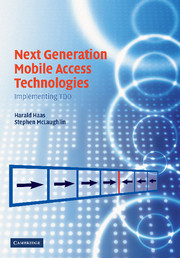Book contents
- Frontmatter
- Contents
- List of abbreviations
- Acknowledgements
- 1 Introduction
- 2 Wireless telecommunications using CDMA and TDD techniques
- 3 Interference and capacity analyses
- 4 Centralised DCA algorithm using the TS-opposing idea
- 5 Distributed DCA algorithm utilising the TS-opposing idea
- 6 UTRA-TDD Opportunity-Driven Multiple Access (ODMA)
- 7 Routing strategies in multi-hop CDMA networks
- 8 Multi-hop DCA
- 9 Radio resource metric estimation
- 10 Interference-based cancellation techniques for TDD
- 11 Smart Antennas for TDD-CDMA Systems
- 12 Cellular OFDMA-TDD
- 1 Derivation of T: Unconstrained Optimisation
- Bibliography
- Index
2 - Wireless telecommunications using CDMA and TDD techniques
Published online by Cambridge University Press: 02 September 2009
- Frontmatter
- Contents
- List of abbreviations
- Acknowledgements
- 1 Introduction
- 2 Wireless telecommunications using CDMA and TDD techniques
- 3 Interference and capacity analyses
- 4 Centralised DCA algorithm using the TS-opposing idea
- 5 Distributed DCA algorithm utilising the TS-opposing idea
- 6 UTRA-TDD Opportunity-Driven Multiple Access (ODMA)
- 7 Routing strategies in multi-hop CDMA networks
- 8 Multi-hop DCA
- 9 Radio resource metric estimation
- 10 Interference-based cancellation techniques for TDD
- 11 Smart Antennas for TDD-CDMA Systems
- 12 Cellular OFDMA-TDD
- 1 Derivation of T: Unconstrained Optimisation
- Bibliography
- Index
Summary
Introduction
With the advent of third generation mobile communication systems TDD technology was applied for the first time to cellular systems. These systems primarily make use of CDMA (code-division multiple access) for managing multiuser access. Therefore, the scope of this chapter is to study the combination of CDMA and TDD technologies applied to cellular systems.
The capacity of cellular systems that use CDMA in combination with frequency-division duplex (FDD) have been intensively studied (Chebaro and Godlewski, 1992; Wu et al., 1997; Corazza et al., 1998; Veeravalli and Sendonaris, 1999; Takeo et al., 2000) following the pioneering papers by (Gilhousen et al., 1991) and (Viterbi and Viterbi, 1994). Gilhousen and Viterbi applied spread-spectrum techniques, which, until then, had primarily been used in military applications, to commercial wireless communication systems — the foundation for which was laid by Shannon's communication theory (Shannon, 1948). Due to its flexibility in supporting various transmission rates, CDMA had been widely adopted for third-generation mobile communication systems. During the European FRAMES (future radio wideband multiple access system) project in the mid nineties, different air interface proposals were investigated including a hybrid TD-CDMA/FDD system (delta concept), results of which are reported in (Ojanperä et al., 1997), (Pehkonen et al., 1997), and (Klein et al., 1997).
The time-division duplex (TDD) technique has been applied successfully to frequency-division multiple access (FDMA) systems and time division-multiple access (TDMA) systems (Esmailzadeh et al., 1997; Horikawa et al., 1997).
- Type
- Chapter
- Information
- Next Generation Mobile Access TechnologiesImplementing TDD, pp. 15 - 53Publisher: Cambridge University PressPrint publication year: 2008



